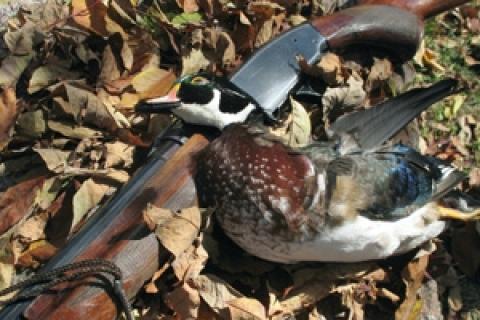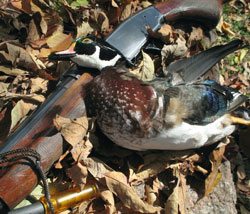

Wood duck hunting has a special place in my heart. The first bird I ever shot was a drake woody that catapulted out of the pickerel weeds just ahead of my canoe. The memory of that duck, rising against the red swamp maples and blue autumn sky is as clear now as it was on that day, some thirty years ago. Since then, I've devoted countless days afield chasing these gorgeous birds. Here's what I've learned along the way.
Find the Right Spot
Being at the right place at the right time is half the trick to any outdoors pursuit, and it's no different when hunting wood duck. Finding that magical combination takes observational skills, a bit of patience and some logic.
First, rule out the unlikely places. Understanding how wood ducks relate to varying water depth makes this easier.
Typically, woodies roost near cover that emerges from deeper or bigger water — places where terrestrial and airborne predators can't easily surprise them in the night.
In our area, one of the biggest early season roost sites is within a cat tail colony in the middle of a big river. In the evening, the woodies and teal pour into the little potholes within it, just as they do in larger isolated potholes in remote parts of the mainland marsh and back bays near the entrances.
Leave the roost alone though. Hunt it too much and wood duck will clear out of the area. Instead, set up for an evening hunt in areas between the feeding areas and the roost. That's because woodies prefer direct flight paths to and from wherever they are going. So setting up between the marsh and the roost area, especially where tree lines funnel them out, can provide fine pass shooting in the evening.
Morning hunts are different. Then, a hunter is better off ambushing the feeding areas. These tend to be areas with water depths of 20 centimeters (8 inches) or less. Often, wood ducks and other dabbling ducks will loaf on logs overlooking these spots too.
 |
| A good dog is a pleasure to share a blind with and will locate birds you would have never found yourself. |
These places hold food such as duck weed, acorns, berries, and the seeds of pickerel weed. They're also where wood ducks pursue aquatic insects and crustaceans that make up a significant portion of their diet.
I've learned to pay special attention to the shallow, secluded corners of marshy pot holes, active beaver ponds, and meandering creeks within wetlands or hardwood bottoms. Likewise, when it comes to acorns, nothing beats a flooded oak stand.
Logs covered in duck droppings with feathers floating nearby also reveal regular hangouts. These are important because, in my experience, until pressured or conditions change, wood duck are creatures of habit. Last fall, I flushed the same drake from the very same log three times before I finally got a shot and folded him.
Decoys
Wood ducks are keen to decoy if the setup is right. In fact, early in the season, unpressured local birds rarely circle twice before dropping in.
My favorite early season spread consists of two drakes and four hen wood duck decoys, which I set up separate from an equal number of mallards, similarly mixed.
For years, I used mallard decoys and did just fine, but wood duck decoys add realism to the spread and, I'm convinced, help when lots of woodies are around. Mallards, blacks, teal and other puddle ducks also find this spread equally attractive, so mixed bags are often the case.
When ducks are nervous, they crowd up first, so a loose setup gives the impression of a relaxed, secure flock. Set decoys at least six feet apart and 20 yards from the blind; the exception is in flooded timber, where you can stand with your back against trees among the decoys, kicking up ripples as you call.
Ducks will invariably land against the wind, so the landing zone within your spread should be placed so a decoying bird's approach and landing is within everyone's shooting arc. I prefer a cross wind from the blind. That way ducks are not passing over or looking directly at you as they land.
 |
| When it comes to camo, Galea believes what's truly important is that the blind is well hidden and that everyone is wearing a camouflaged face mask and hat. |
I place most decoys on the edge of the pickerel weeds, rushes, or in the duck weed as if they are feeding. But some should also be in whatever current is available. The idea is to strike a balance between realism and visibility; it's no good to have a great decoy spread if the ducks don't see it.
Dress for Success
Camouflage and comfort are key considerations in waterfowling attire. Obviously, your camouflage should blend with your surroundings, but a good duck blind will cover up a lot of mistakes too; that's why I never fret if my camo isn't exact. To me, what's truly important is that the blind is well hidden and that everyone is wearing a camouflaged face mask and hat. These are particularly important because ducks will see a shiny face or light-colored hair popping over the edge of the blind from surprising distances.
A good set of chest waders is important too. Even if you are using a boat or canoe, sometime during the hunt, perhaps when handling a retriever, waders will come in handy.
Call of the Wild
Though you can do well without ever using a call, the proper and judicious use of a wood duck call will give you the edge. The best are easy to use and sound great.
They are particularly effective when hunting flooded timber where their high pitched peeps filter through the canopy to passing birds or those loafing out of sight.
If I see woodies in the distance or if they have swung wide of my decoys and are on the way out, I'll also give them a squeal. Additionally, I'll call when I hear but do not see birds in the air, on foggy days, and at first light in response to wood ducks vocalizing on the water. Like most duck calling, a little goes a long way and it pays to watch the bird's reaction if you can see it.
Listen
Few other puddle ducks are as vocal as early-season wood ducks, especially when they are approaching decoys, or are on the water in early morning. That's why it pays to listen for them, particularly when you are hunting in tight places like small brush-choked ponds or willow swamps.
Often their call will give you just enough time to duck, freeze, or get ready to shoot. This makes the difference between being caught flat-footed and doubling.
Shotguns
I use a 12-gauge pump for all waterfowling. Most of my buddies use autoloaders. The similarities are that they are quick-handling and hold a trio of 3-inch shells. We rely on #4 steel shot and #5 in non-toxic loads which handle any early season duck nicely.
It's hard to beat a modified choke on a 26 or 28 inch barrel too. The exception, again, is in flooded timber or really tight cover where a more open choke will prove its worth.
Value of a Good Dog
Every waterfowler should own a well-trained retriever. I currently own an English Springer Spaniel and a Labrador Retriever.
A good dog is a pleasure to share a blind with and will locate birds you would have never found yourself. It's amazing how a bird as gaudy as a drake wood duck can hide in plain sight. It's even more amazing how a good retriever can find downed birds in some of the hellish cover they end up in. If you want to take your waterfowling to the next level, you really need a duck dog.
Food for Thought
 Wood duck are among our finest tasting waterfowl. No surprise since they eat (among other things) acorns and berries. It doesn't hurt that their delicate feathers are great for fly tying or that they are perhaps the most beautiful North American duck there is. You'd think that these are reasons enough to target wood ducks. But I think there's more to it than that.
Wood duck are among our finest tasting waterfowl. No surprise since they eat (among other things) acorns and berries. It doesn't hurt that their delicate feathers are great for fly tying or that they are perhaps the most beautiful North American duck there is. You'd think that these are reasons enough to target wood ducks. But I think there's more to it than that.
Sometime during your first successful wood duck hunt, when there's a break in the shooting, and right after your dog has brought to hand another gorgeous drake, you'll look around and notice the sun lighting up the cat tails. As a cool autumn breeze sweeps through and makes your decoys dance, you'll then marvel at the ochers, yellows and golds on the surrounding hillsides and little swamp islands. Then, somewhere beyond the tree line, a distant wood duck will sound off, wild and defiant, and your dog's ears will perk up a bit. Right about then, you'll smile and swear you'll be back soon. Wood ducks just have that effect on a person.
- 22715 views

